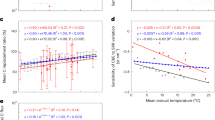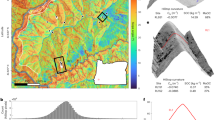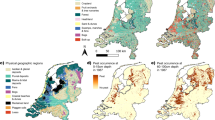Abstract
Soils are the main terrestrial reservoir of nutrients, such as nitrogen and phosphorus, and of organic carbon. Synthesizing earlier studies, we find that the mobilization and deposition of agricultural soils can significantly alter nutrient and carbon cycling. Specifically, erosion can result in lateral fluxes of nitrogen and phosphorus that are similar in magnitude to those induced by fertilizer application and crop removal. Furthermore, the translocation and burial of soil reduces decomposition of soil organic carbon, and could lead to long-term carbon storage. The cycling of carbon, nitrogen and phosphorus are strongly interrelated. For example, erosion-induced burial of soils stabilizes soil nutrient and carbon pools, thereby increasing primary productivity and carbon uptake, and potentially reducing erosion. Our analysis shows soils as dynamic systems in time and space.
This is a preview of subscription content, access via your institution
Access options
Subscribe to this journal
Receive 12 print issues and online access
$259.00 per year
only $21.58 per issue
Buy this article
- Purchase on Springer Link
- Instant access to full article PDF
Prices may be subject to local taxes which are calculated during checkout


Similar content being viewed by others
References
Davidson, E. A. & Janssens, I. A. Temperature sensitivity of soil carbon decomposition and feedbacks to climate change. Nature 440, 165–173 (2006).
Heimann, M. & Reichstein, M. Terrestrial ecosystem carbon dynamics and climate feedbacks. Nature 451, 289–292 (2008).
Stallard, R. F. Terrestrial sedimentation and the carbon cycling: coupling weathering and erosion to carbon burial. Glob. Biogeochem. Cycles 12, 231–257 (1998).
Batjes, N. H. ISRIC-WISE Global Data Set of Derived Soil Properties on a 0.5 by 0.5 Degree Grid (Version 3.0): Report 2005/08 (ISRIC–World Soil Information, 2005).
Smil, V. Agriculture's largest harvest. BioScience 49, 299–308 (1999).
Seitzinger, S. P., Harrison, J. A., Dumont, E., Beusen, A. H. W. & Bouwman, A. F. Sources and delivery of carbon, nitrogen, and phosphorus to the coastal zone: An overview of global nutrient export from watersheds (NEWS) models and their application. Glob. Biogeochem. Cycles 19, GB4S01 (2005).
Beusen, A. H. W., Dekkers, A. L. M., Bouwman, A. F., Ludwig, W. & Harrison, J. Estimation of global river transport of sediments and associated particulate C, N, and P. Glob. Biogeochem. Cycles 19, GB4S05 (2005).
Smil, V. in Encyclopedia of Global Environmental Change: Volume 3, Causes and Consequences of Global Environmental Change (ed. Douglas, I.) 536–542 (Wiley, 2002).
Lal, R. Soil erosion and the global carbon budget. Environ. Int. 29, 437–450 (2003).
Van Oost, K. et al. The impact of agricultural soil erosion on the global carbon cycle. Science 318, 626–629 (2007).
Van Hemelryck, H., Fiener, P., Van Oost, K. & Govers, G. The effect of soil redistribution on soil organic carbon: an experimental study. Biogeosciences Discuss. 6, 5031–5071 (2009).
Cole, J. et al. Plumbing the global carbon cycle: integrating inland waters into the terrestrial carbon budget. Ecosystems 10, 172–185 (2007).
van de Koppel, J., Rietkerk, M. & Weissing, F. J. Catastrophic vegetation shifts and soil degradation in terrestrial grazing systems. Trends Ecol. Evol. 12, 352–356 (1997).
Berhe, A., Harte, J., Harden, J. & Torn, M. The significance of the erosion-induced terrestrial carbon sink. BioScience 57, 337–346 (2007).
Harden, J. W. et al. Dynamic replacement and loss of soil carbon on eroding cropland. Glob. Biogeochem. Cycles 13, 885–901 (1999).
Rosenbloom, N. A., Harden, J. W., Neff, J. C. & Schimel, D. S. Geomorphic control of landscape carbon accumulation. J. Geophys. Res. 111, G01004 (2006).
Fontaine, S. et al. Stability of organic carbon in deep soil layers controlled by fresh carbon supply. Nature 450, 277–280 (2007).
Gabet, E. J. & Mudd, S. M. A theoretical model coupling chemical weathering rates with denudation rates. Geology 37, 151–154 (2009).
Riebe, C., Kirchner, J., Granger, D. & Finkel, R. Strong tectonic and weak climatic control of long-term chemical weathering rates. Geology 29, 511–514 (2001).
Jacinthe, P. A., Lal, R. & Kimble, J. M. Carbon dioxide evolution in runoff from simulated rainfall on long-term no-till and plowed soils in southwestern Ohio. Soil Till. Res. 66, 23–33 (2002).
Inoue, Y., Baasansuren, J. Watanabe, M., Kamei, H. & Lowe, D. J. Interpretation of pre-AD 472 Roman soils from physicochemical and mineralogical properties of buried tephric paleosols at Somma Vesuviana ruin, southwest Italy. Geoderma 152, 243–251 (2009).
van Groenigen, K.-J. et al. Element interactions limit soil carbon storage. Proc. Natl Acad. Sci. USA 103, 6571–6574 (2006).
Rao, W., Chen, J., Luo, T. & Liu, L. Phosphorus geochemistry in the Luochuan loess section, North China and its paleoclimatic implications. Quat. Int. 144, 72–83 (2006).
Filippelli, G. M. The global phosphorus cycle: Past, present, and future. Elements 4, 89–95 (2008).
Chadwick, O., Derry, L., Vitousek, P., Huebert, B. & Hedin, L. Changing sources of nutrients during four million years of ecosystem development. Nature 397, 491–497 (1999).
Stocking, M. A. Tropical soils and food security: The next 50 years. Science 302, 1356–1359 (2003).
Sharpley, A. N. The selective erosion of plant nutrients in runoff. Soil Sci. Soc. Am. J. 49, 1527–1534 (1985).
Tisdall, J. & Oades, J. Organic matter and water-stable aggregates in soils. J. Soil Sci. 33, 141–163 (1982).
Elwell, H. & Stocking, M. Vegetal cover to estimate soil erosion hazard in Rhodesia. Geoderma 15, 61–70 (1976).
Woodward, F. I., Bardgett, R. D., Raven, J. A. & Hetherington, A. M. Biological approaches to global environment change mitigation and remediation. Curr. Biol. 19, 615–623 (2009).
Reay, D., Dentener, F., Smith, P., Grace, J. & Feely, R. Global nitrogen deposition and carbon sinks. Nature Geosci. 1, 430–437 (2008).
Kaye, J. P. & Hart, S. C. Competition for nitrogen between plants and soil microorganisms. Trends Ecol. Evol. 12, 139–143 (1997).
Bardgett, R. D. The Biology of Soil: A Community and Ecosytems Approach 1st edn (Oxford Univ. Press, 2005).
Wardle, D. A., Walker, L. R. & Bardgett, R. D. Ecosystem properties and forest decline in contrasting long-term chronosequences. Science 305, 509–513 (2004).
Wardle, D. A., Bardgett, R. D., Walker, L. R. & Bonner, K. Among- and within-species variation in plant litter decomposition in contrasting long-term chronosequences. Funct. Ecol. 23, 442–453 (2009).
Bakker, M. M. et al. Soil erosion as a driver of land-use change. Agr. Ecosyst. Environ. 105, 467–481 (2005).
Feddema, J. J. et al. The importance of land-cover change in simulating future climates. Science 310, 1674–1678 (2005).
Acknowledgements
K.V.O is a research associate of the Fonds de la Recherche Scientifique (FNRS), Belgium, and is supported by the Communauté Française de Belgique (convention number 09/14-022).
Author information
Authors and Affiliations
Contributions
J.Q. led the writing of the paper. K.V.O. conducted the model simulations and contributed to the writing, together with G.G. and R.B.
Corresponding author
Supplementary information
Supplementary Information
Supplementary Information (PDF 402 kb)
Rights and permissions
About this article
Cite this article
Quinton, J., Govers, G., Van Oost, K. et al. The impact of agricultural soil erosion on biogeochemical cycling. Nature Geosci 3, 311–314 (2010). https://doi.org/10.1038/ngeo838
Published:
Issue Date:
DOI: https://doi.org/10.1038/ngeo838
This article is cited by
-
Erosion-induced recovery CO2 sink offset the horizontal soil organic carbon removal at the basin scale
Science China Earth Sciences (2024)
-
Climate change and geo-environmental factors influencing desertification: a critical review
Environmental Science and Pollution Research (2024)
-
Isotopic Composition of Carbon and Nitrogen of Particulate Organic Matter in the Godavari Estuary: Seasonality in Sources and Processes
Estuaries and Coasts (2024)
-
Erosion and deposition controlling redistribution and biodegradation of nitrogen fractions along a Mollisol agricultural landscape
Journal of Soils and Sediments (2024)
-
Erosion and deposition significantly affect the microbial diversity, co-occurrence network, and multifunctionality in agricultural soils of Northeast China
Journal of Soils and Sediments (2024)



